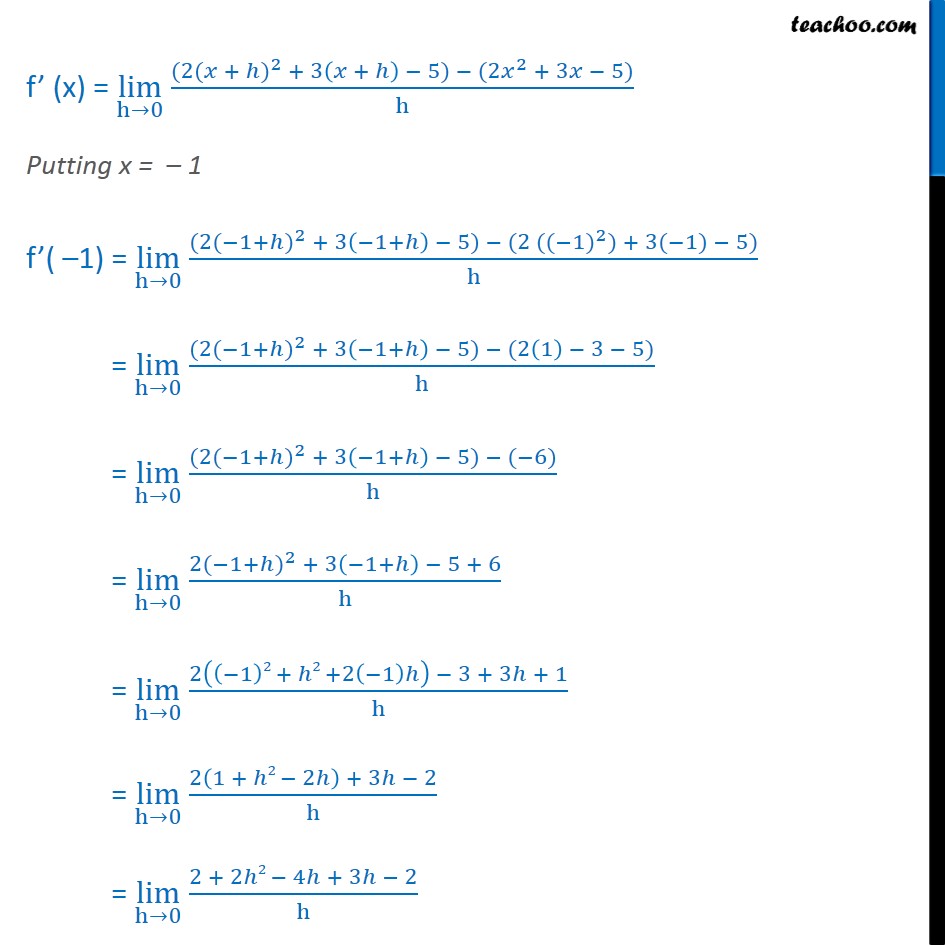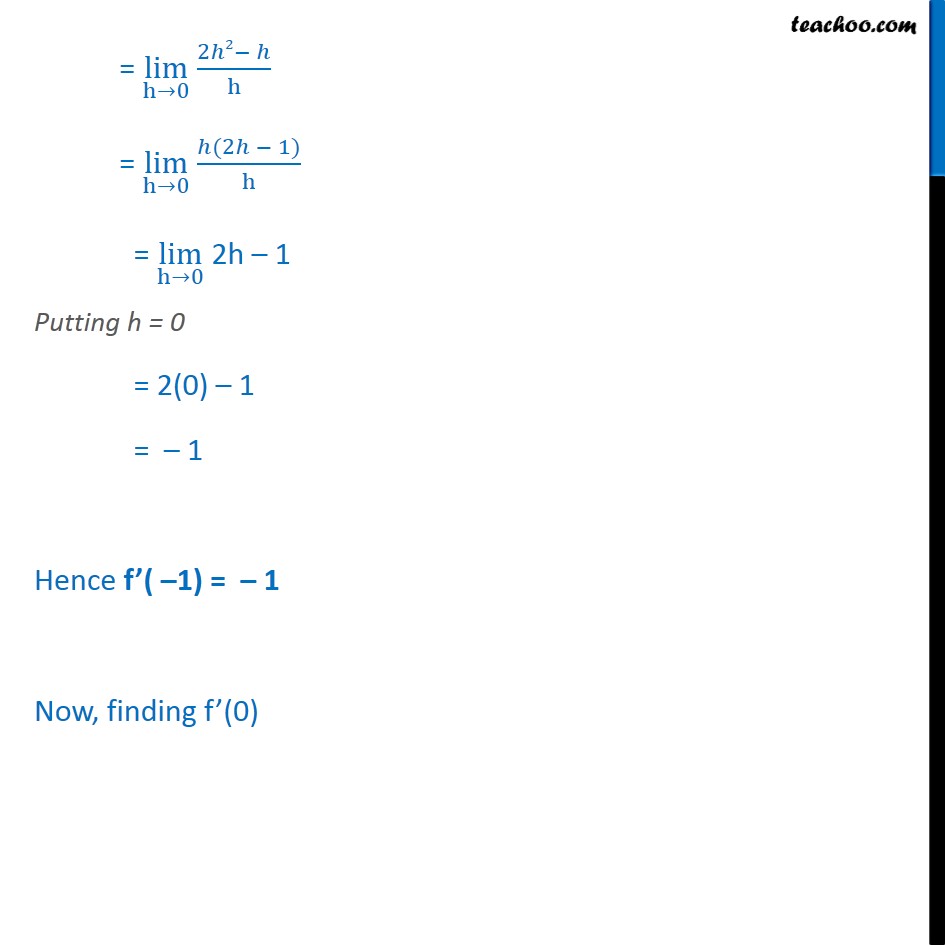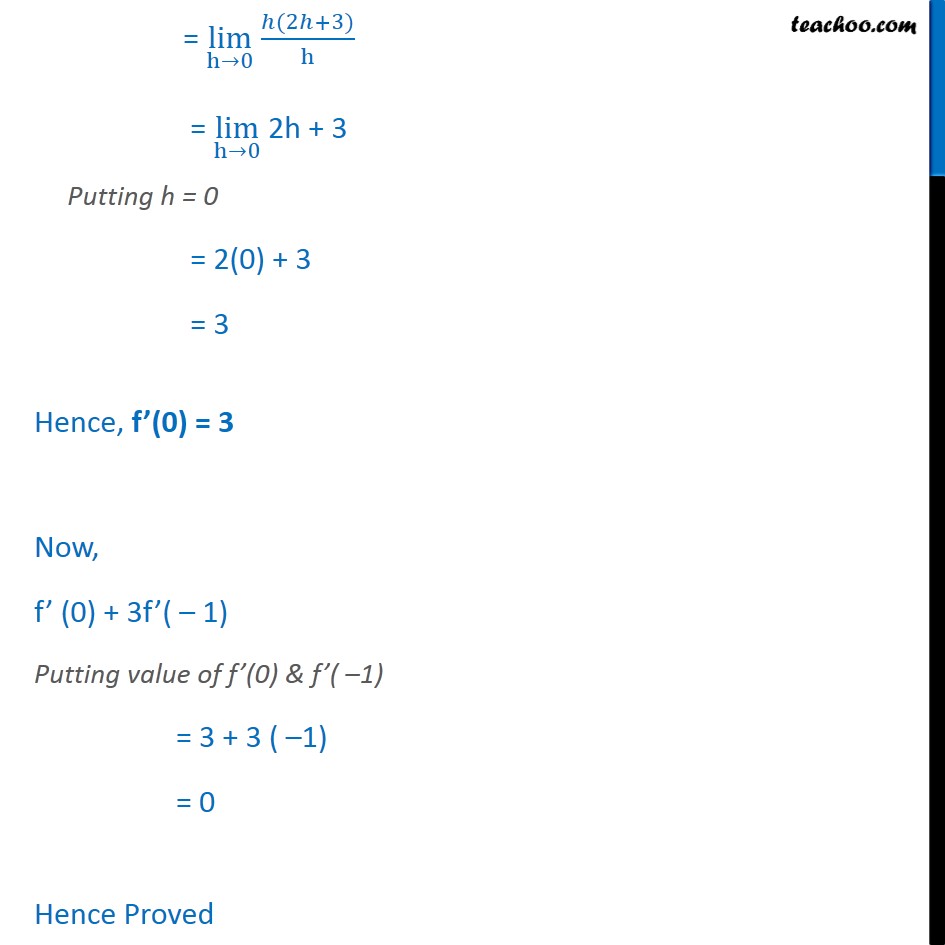






Examples
Last updated at Dec. 16, 2024 by Teachoo







Transcript
Example ,6 (Method 1) Find the derivative of the function f(x) = 2x2 + 3x – 5 at x = –1. Also prove that f’(0) + 3f’( –1) = 0. Given f(x) = 2x2 + 3x – 5 We know that f’(x) = limh→0 f 𝑥 + ℎ − f (x)h Now f (x) = 2x2 + 3x – 5 So, f (x + h) = 2(x + h)2 + 3(x + h) – 5 Putting values f’ (x) = limh→0 (2(𝑥 + ℎ)2 + 3 𝑥 + ℎ − 5) − (2𝑥2 + 3𝑥 − 5)h f’ (x) = limh→0 (2(𝑥 + ℎ)2 + 3 𝑥 + ℎ − 5) − (2𝑥2 + 3𝑥 − 5)h Putting x = – 1 f’( –1) = limh→0 (2(−1+ℎ)2 + 3 −1+ℎ − 5) − (2 ((−1)2) + 3(−1) − 5)h = limh→0 (2(−1+ℎ)2 + 3 −1+ℎ − 5) − (2 1 − 3 − 5)h = limh→0 (2(−1+ℎ)2 + 3 −1+ℎ − 5) − (−6)h = limh→0 2(−1+ℎ)2 + 3 −1+ℎ − 5 + 6h = limh→0 2 −12 + ℎ2 +2 −1ℎ − 3 + 3ℎ + 1h = limh→0 2 1 + ℎ2 − 2ℎ + 3ℎ − 2h = limh→0 2 + 2ℎ2 − 4ℎ + 3ℎ − 2h = limh→0 2ℎ2− ℎh = limh→0 ℎ(2ℎ − 1)h = limh→0 2h – 1 Putting h = 0 = 2(0) – 1 = – 1 Hence f’( –1) = – 1 Now, finding f’(0) For f’(0) f’(x)= limh→0 𝑓 𝑥 + ℎ − 𝑓(𝑥)ℎ f’(x)= limh→0 2 𝑥 + ℎ2 + 3 𝑥 + ℎ − 5 −[2𝑥2 + 3𝑥 − 5]ℎ putting x = 0 f’(0)= limh→0 2 0 + ℎ2 + 3 0 + ℎ − 5 −[2(0)2 + 3(0) − 5]ℎ f’(0)= limh→0 2ℎ2 + 3ℎ − 5 − [0 + 0 − 5]ℎ f’(0)= limh→0 2ℎ2 + 3ℎ − 5 + 5ℎ f’(0)= limh→0 2ℎ2 + 3ℎℎ = limh→0 ℎ(2ℎ+3)h = limh→0 2h + 3 Putting h = 0 = 2(0) + 3 = 3 Hence, f’(0) = 3 Now, f’ (0) + 3f’( – 1) Putting value of f’(0) & f’( –1) = 3 + 3 ( –1) = 0 Hence Proved Example 6 (Method 2) Find the derivative of the function f(x) = 2x2 + 3x – 5 at x = –1. Also prove that f’(0) + 3f’( –1) = 0. Given f(x) = 2x2 + 3x – 5 Now, f’(x) = (2x2 + 3x – 5)’ = 2(2.x2–1) + 3(1.x1–1) – 0 = 2(2x1) + 3(1) = 4x + 3 Putting x = 0 f’(0) = 4(0) + 3 = 0 + 3 = 3 Taking f’ (0) + 3f’( – 1) Putting value of f’(0) & f’( –1) = 3 + 3 ( –1) = 3 – 3 = 0 Hence Proved